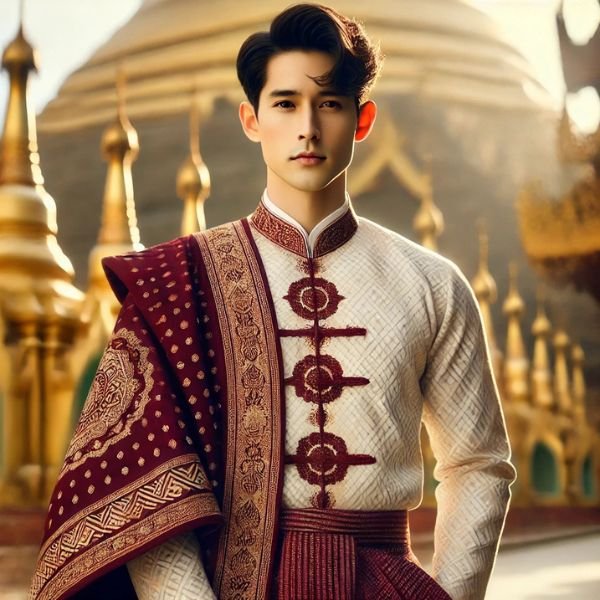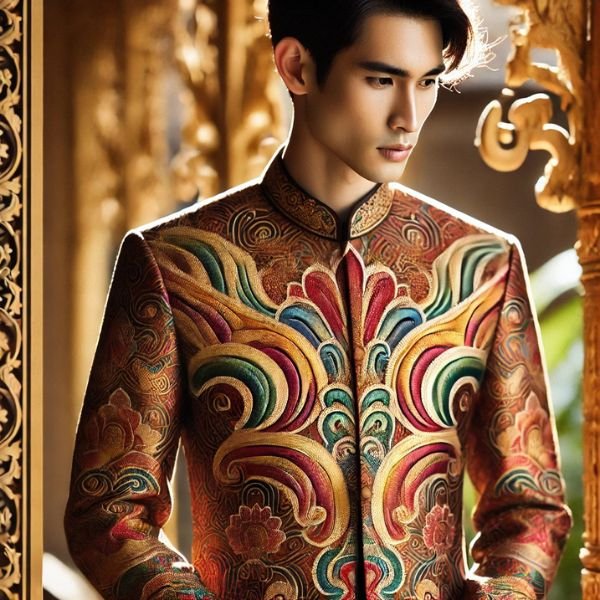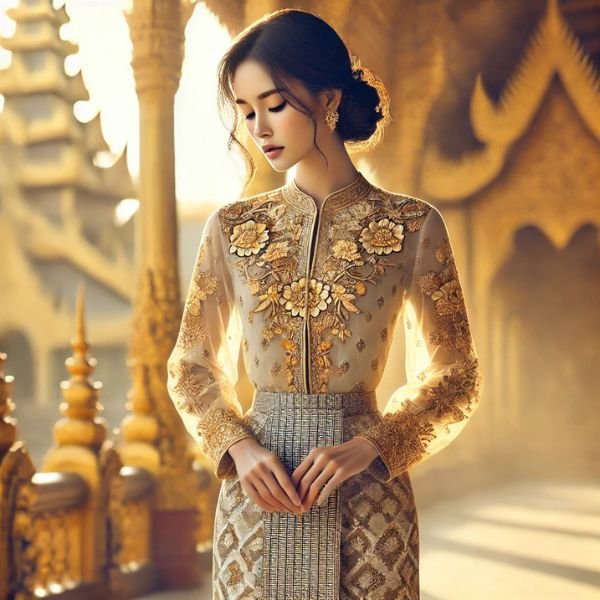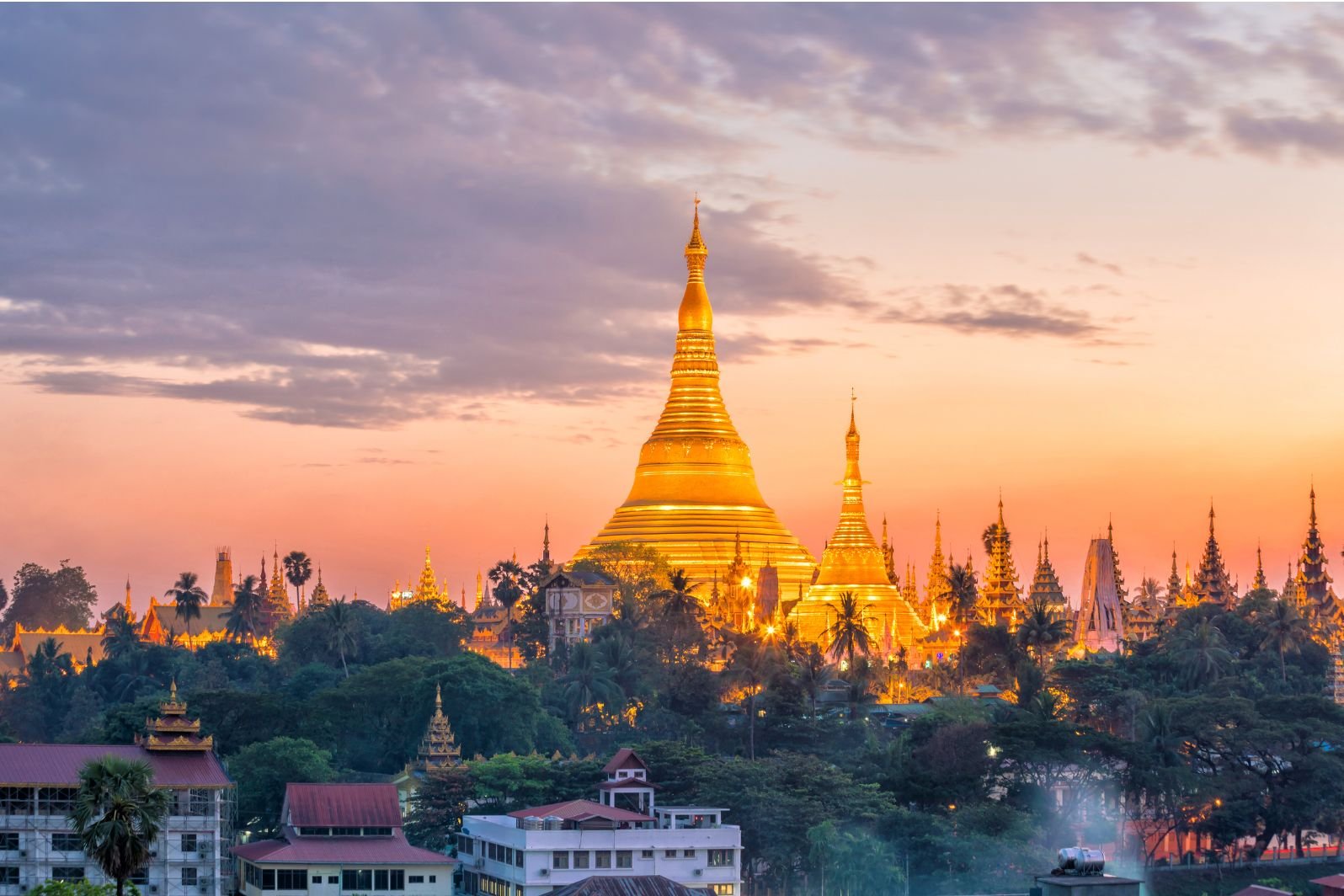The “golden land” of Myanmar is famous for its spiritually linked culture and heritage. While most people know the country for its rich history and beautiful temples, Myanmar’s list of treasures exceeds it. One of the most important and treasured cultural heritage of the country is their traditional dress. The traditional dress of Myanmar, better known as the national dress, is called the longyi.
The origin of the longyi is associated with the influence of the Swadeshi movement in India. It is Inspired by the sentiments of promoting national and traditional dresses as a peaceful protest against colonial rule, the longyi was introduced and worn in Myanmar (then Burma) as a way of expressing anti-colonial sentiments. The longyi is worn by both men and women in Myanmar. The fascinating thing about the national dress is its diversity in terms of color, design, and weaving.
Apart from the longyi, Myanmar has many other traditional dresses. So, let’s explore what are the other different traditional dresses of Myanmar.
Traditional Dress of Men
Since the oldest times, the traditional dress of Myanmar for men has retained a similar design of a dhoti-like garment and a unique traditional jacket. Here are some of the traditional dresses that many Myanma people still wear to this date.
1. Paso or Pahso
The Paso or Pahso, the men’s version of longyi, is a traditional garment similar to a sarong. It is a rectangular piece of cloth, typically 2 meters long and 80 centimeters wide, which men wrap around their waist and tie tightly in the front with a simple knot.
There are many different variants of the Paso, which are named as per their weaves or ethnic origin of the weave. For example, there are the Rakhine longyi, Kachin longyi, and many more. The Rakhine longyioften feature stripes or zigzag motifs in contrasting hues, reflecting the Rakhine region’s coastal culture and ethnic traditions. On the other hand, the Kachin longyi,mostly worn by Kachin people living in the Northern region of Myanmar, typically has a tartan or geometric pattern, which is a symbolic design of handmade Kachin fabrics.

2. Acheik
The Acheik Paso is the most importantvariant of the traditionallongyi for men. The fabric is characterized by complex wave patterns, which are woven and indicate the long heritage weaving traditions of Myanmar. Because of its complexity and the skill needed to weave it, this type of design is often called a “hundred-shuttle” weave. It is reserved for ceremonial settings or religious festivals.

3. Bangauk Paso
The Bangauk Paso sets itself apart from other longyi for men with its reserved color palette and fitted cut, making it a truly unique style of Paso. Frequently worn by trades or at formal events, it is a representation of sophistication and subtle elegance. While the patterns of the Bangauk Paso are less ornate than those of the Acheik, they still show intricate lines that make them unique. The Bangauk Paso beautifully expresses the cultural identity of Myanmar with its subtle type floral and geometric motifs.

Check Also: Traditional Dress of South Korea
Traditional Dress of Women
The traditional dress of Myanmar for women is similar to that of men, with subtle differences. Women also wear the longyi, albeit in a different way. Along with the women’s version of longyi, women pair the attire with a traditional blouse or jacket. Here are some of the traditional dresses that women wear.
1. Htamein
The Htamein is the feminine version of the longyi, but it is sewn in such a way that makes it more graceful and feminine. Unlike the Paso, the Htamein is sewn into a cylindrical shape, making it easier to drape. It is fastened at the waist by tucking it or tying it with a knot, and is also distinguished by the bright, vibrant-colored floral or geometric patterns. Htamein may either be made of cotton for casual wear or silk for amore special event, combined with intricate embroidery or embellishment that commonly adorn the traditional Htamein.

2. Eingyi
The Eingyi is a traditional blouse worn with the Htamein. It comes in various styles, ranging from fitted, buttoned tops to loose, flowing designs. Eingyi blouses are typically made from cotton, silk, or lace and are adorned with intricate embroidery, making them suitable for both everyday wear and formal occasions. For special events, women often wear Eingyi featuring detailed hand-sewn patterns and paired with a matching shawl or scarf.

3. Yinzi and Yinbon
Yinzi and Yinbon are traditional jackets or outer garments worn by women over the Eingyi. The Yinzi is a fitted jacket with buttons down the front, often made of silk or brocade. It is known for its tailored fit and refined appearance, making it a popular choice for formal events. The Yinbon, on the other hand, is a more ornate jacket featuring rich embroidery, intricate beadwork, or sequins. Worn during ceremonies or celebrations, it complements the Htamein and adds a regal touch to the attire.

Check Also: Traditional Dress Japan
Traditional Dress for Children
The traditional dress for children in Myanmar reflects the vibrant culture and deep-rooted traditions of the country. Similar to adults, children also wear the longyi, albeit in smaller sizes. Boys wear the Paso, the male version of the longyi, which is tied securely around the waist and adjusted for their comfort. Girls wear the Htamein, the feminine counterpart, in bright hues with floral or geometric designs that showcase the same elegance as adult attire. For special occasions, children’s traditional outfits are further embellished with intricate embroidery or beads, symbolizing the cultural significance of the event.
In addition to the longyi, children often pair their outfits with miniature versions of traditional tops, such as the Eingyi for girls and simple cotton shirts for boys. During festivals or ceremonies, children may wear traditional jackets, like the Yinzi or Yinbon, designed with age-appropriate embellishments to maintain their playful charm. These traditional outfits not only make children look adorable but also instill a sense of pride and connection to their cultural heritage from a young age. Myanmar’s traditional dress for children, much like for adults, is a beautiful representation of the nation’s rich textile artistry and cultural legacy.

Traditional Dress of Myanmar – Preserving Culture Through Attire
The traditional dress of Myanmar is a symbol of cultural heritage and arts. These garments, from the colorful Htamein to the exquisitely embroidered Yinzi and Yinbon, are a source of pride and identity for women and men of all ages, even children.
By continuing to don the traditional dress, Myanmar keeps its cultural roots alive and tells its story to the world. Be it for work wear or ceremonial traditions, these traditional clothing continue to bridge the gap between generations, tying them to theroots of their heritage while keeping the spirit of Myanmar alive for years to come.
